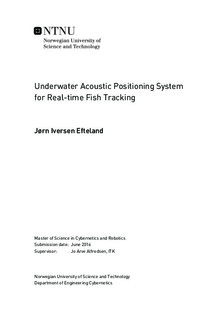Underwater Acoustic Positioning System for Real-time Fish Tracking
Master thesis
Permanent lenke
http://hdl.handle.net/11250/2417993Utgivelsesdato
2016Metadata
Vis full innførselSamlinger
Sammendrag
This master thesis describes an implementation of an underwater acoustic positioning system for real-time fish tracking in large-scale aquaculture sea cages, as well as experimental tests conducted with system developed. The positioning system is to be based on hydrophones of type TBR700-RT and Thelma Biotel transmitter tags. It is a passive acoustic localization system, which means that the transmitting node is to be located based on signal reception at the hydrophones. For localization, the method of time difference of arrival (TDOA) was used in combination with a pressure sensor.
Firstly, theoretical groundwork for the system is shown. That includes derivations of the positioning equations, algorithms and methods for software implmentation and considerations for the special case of underwater sound.
As the TDOA method presupposes accurate clock synchronization, a surface support module (SSM) was developed, utilizing GPS technology to synchronize the clocks of the hydrophones. This thesis will describe how to utilize the SSM to bridge the hydrophones to the internet, enabling fish-tracking in real time.
Lastly, experimental tests will be presented in order to evaluate the precision of the system. Some experiments done in November 2015 involved fish tracking, and was parsed by the developed algorithm. These results will also be discussed briefly.
The experimental tests showed the system to perform well. Within a sea cage where hydrophones were mounted in an equilateral triangle on the periphery, the system was precise within a margin of $\pm2m$ for most transmitter positions. However, the deviations on the position estimates are dependent on the transmitter's relative geometry to the receiver array, and is thus variable. Near the middle of the cage, the precision was about $\pm1m$. It has thus been shown that the system is useful for monitoring fish motion in sea cages.
